Design and Characterization of Peptide-Based Self-Assembling Microgel for Encapsulation of Sesaminol
Abstract
:1. Introduction
2. Materials and Methods
2.1. Materials and Reagents
2.2. Synthesis and Characterization of Peptides
2.3. Preparation of Peptide Microgel
2.4. Morphology Characteristics
2.5. Fluorescence Spectroscopy Analysis
2.5.1. Intrinsic Fluorescence Assay
2.5.2. ThT Fluorescence Assay
2.5.3. Critical Aggregation Concentration (CAC) Fluorescence Assay
2.6. Circular Dichroism (CD) Spectroscopy Analysis
2.7. Nuclear Magnetic Resonance (NMR) Spectroscopy Analysis
2.8. Molecular Dynamic (MD) Simulations Analysis
2.9. Encapsulation Efficiency
2.10. Crystallinity Analysis
2.11. Antioxidant Ability
2.12. Simulated In Vitro Digestion
2.13. Bioaccessibility Analysis
2.14. Molecular Docking
2.15. Statistical Analysis
3. Results and Discussion
3.1. Sequence Design and Characterization of Peptides
3.2. Self-Assembly Behavior of Peptides
3.2.1. Effect of YY Modified by Amino Acids with Different Length Alkane Chains
3.2.2. Micromorphology Characteristics of LYY Self-Assembly Structure
3.3. Mapping the Mechanism of LYY Microgel
3.3.1. Fluorescence Spectroscopy
3.3.2. Circular Dichroism (CD) Spectroscopy
3.3.3. Nuclear Magnetic Resonance (NMR) Spectroscopy
3.3.4. Molecular Dynamic (MD) Simulations
3.4. Encapsulation Efficiency of Sesaminol in LYY-Microgel
3.5. Morphology Characteristics of Sesaminol–LYY Microgel
3.6. Crystallinity
3.7. Antioxidant Activity
3.8. In Vitro Simulated Digestion
3.9. Bioaccessibility
3.10. Molecular Docking of Sesaminol with LYY and LYY Self-Assembly Structure
4. Conclusions
Supplementary Materials
Author Contributions
Funding
Institutional Review Board Statement
Informed Consent Statement
Data Availability Statement
Conflicts of Interest
References
- Li, Q.Z.; Zuo, Z.W.; Liu, Y. Recent status of sesaminol and its glucosides: Synthesis, metabolism, and biological activities. Crit. Rev. Food Sci. Nutr. 2023, 63, 12043–12056. [Google Scholar] [CrossRef] [PubMed]
- Ohira, H.; Oikawa, D.; Kurokawa, Y.; Aoki, Y.; Omura, A.; Kiyomoto, K.; Nakagawa, W.; Mamoto, R.; Fujioka, Y.; Nakayama, T. Suppression of colonic oxidative stress caused by chronic ethanol administration and attenuation of ethanol-induced colitis and gut leakiness by oral administration of sesaminol in mice. Food Funct. 2022, 13, 9285–9298. [Google Scholar] [CrossRef] [PubMed]
- Rajendran, R.; Suman, S.; Divakaran, S.J.; Swatikrishna, S.; Tripathi, P.; Jain, R.; Sagar, K.; Rajakumari, S. Sesaminol alters phospholipid metabolism and alleviates obesity-induced NAFLD. FASEB J. 2024, 38, e23835. [Google Scholar] [CrossRef]
- Watanabe, M.; Iizumi, Y.; Sukeno, M.; Iizuka-Ohashi, M.; Sowa, Y.; Sakai, T. The pleiotropic regulation of cyclin D1 by newly identified sesaminol-binding protein ANT2. Oncogenesis 2017, 6, e311. [Google Scholar] [CrossRef]
- Sengupta, P.; Das, D.; Bhattacharya, S.; Sur, R.; Bose, A.; Sen, K. A pH-driven method for liposomal encapsulation of dietary flavonoid rutin: Sustained release and enhanced bioefficacy. Food Biosci. 2023, 52, 102392. [Google Scholar] [CrossRef]
- Li, Y.W.; Yao, L.; Zhang, L.W.; Zhang, Y.S.; Zheng, T.; Liu, L.; Zhang, L. Enhanced physicochemical stabilities of cyanidin-3-O-glucoside via combination with silk fibroin. Food Chem. 2021, 355, 129479. [Google Scholar] [CrossRef] [PubMed]
- Song, H.D.; Ren, S.X.; Wang, X.Y.; Hu, Y.W.; Xu, M.D.; Zhang, H.; Cao, H.W.; Huang, K.; Wang, C.T.; Guan, X. Encapsulation of caffeic acid phenethyl ester by self-assembled sorghum peptide nanoparticles: Fabrication, storage stability and interaction mechanisms. Food Chem. 2024, 453, 139642. [Google Scholar] [CrossRef]
- Chen, H.M.; Liu, Z.Y.; Li, L.H.; Cai, X.X.; Xiang, L.W.; Wang, S.Y. Peptide Supramolecular Self-assembly: Regulatory Mechanism, Functional Properties, and Its Application in Foods. J. Agric. Food Chem. 2024, 72, 5526–5541. [Google Scholar] [CrossRef]
- Ozawa, N.; Nishimura, T. Macromolecular architectural effects on solution self-assembly of amphiphilic AB-type block copolymers. Polym. Chem. 2024, 15, 349–370. [Google Scholar] [CrossRef]
- Li, X.Y.; Dai, L.; Li, W.; Wu, M.Z.; Zhan, W.M.; Cheng, T.; He, P.; Xiong, C.Y. A self-assembly all-polysaccharide hydrogel for the aquatic heavy metal ions management and utilization. Ind. Crop. Prod. 2023, 203, 117236. [Google Scholar] [CrossRef]
- Solomonov, A.; Kozell, A.; Shimanovich, U. Designing multifunctional biomaterials via protein self-assembly. Angew. Chem. Int. Edit. 2024, 63, e202318365. [Google Scholar] [CrossRef] [PubMed]
- Yong, Y.Y.; Ahmad, H.N.; Gu, Y.Y.; Zhu, X.T.; Wen, Y.H.; Guo, L.H.; Zhu, J. The synergistic effect of polyphenols and polypeptides for plant-based bioplastic film—Enhanced UV resistance, antioxidant and antibacterial performance. Food Chem. 2024, 460, 140746. [Google Scholar] [CrossRef] [PubMed]
- Dimmito, M.P.; Marinelli, L.; Cacciatore, I.; Toto, E.C.; Albertini, B.; Fontana, A.; Pilato, S.; Reale, M.; Costantini, E.; Pesce, C.; et al. From self-assembly to healing: Engineering ultra-small peptides into supramolecular hydrogels for controlled drug release. Int. J. Pharm. 2024, 663, 124562. [Google Scholar] [CrossRef] [PubMed]
- Qiu, F.; Chen, Y.Z.; Tang, C.K.; Zhao, X.J. Amphiphilic peptides as novel nanomaterials: Design, self-assembly and application. Int. J. Nanomed. 2018, 13, 5003–5022. [Google Scholar] [CrossRef]
- Feng, L.; Ren, P.; Hao, L.N.; Dong, Q.Q.; Li, J.L.; Jian, H.L.; Wang, M.Y.; Li, X.; Wang, A.H.; Bai, S. Fabrication of short peptide cages by interfacial self-assembly on CaCO3 templates. Colloids Surf. A Physicochem. Eng. Asp. 2019, 573, 22–29. [Google Scholar] [CrossRef]
- Caprio, N.D.; Davidson, M.D.; Daly, A.C.; Burdick, J.A. Injectable MSC Spheroid and Microgel Granular Composites for Engineering Tissue. Adv. Mater. 2024, 36, 2312226. [Google Scholar] [CrossRef]
- Arif, M. Exploring microgel adsorption: Synthesis, classification, and pollutant removal dynamics. RSC. Adv. 2024, 14, 9445–9471. [Google Scholar] [CrossRef]
- Ramirez-Calderon, G.; Susapto, H.H.; Hauser, C.A.E. Delivery of Endothelial Cell-Laden Microgel Elicits Angiogenesis in Self-Assembling Ultrashort Peptide Hydrogels In Vitro. ACS Appl. Mater. 2021, 13, 29281–29292. [Google Scholar] [CrossRef]
- Durand, E.; Beaubier, S.; Ilic, I.; Fine, F.; Kapel, R.; Villeneuve, P. Production and antioxidant capacity of bioactive peptides from plant biomass to counteract lipid oxidation. Curr. Opin. Food Sci. 2021, 4, 365–397. [Google Scholar] [CrossRef] [PubMed]
- Mayes, M.L.; Perreault, L. Probing the Nature of Noncovalent Interactions in Dimers of Linear Tyrosine-Based Dipeptides. ACS Omega 2019, 4, 911–919. [Google Scholar] [CrossRef]
- Mayes, M.L.; Perreault, L. Conformational structures and vibrational spectroscopic investigation of isolated dityrosine and tryptophan-tyrosine dipeptides: A theoretical study. Comput. Theor. Chem. 2018, 1131, 99–109. [Google Scholar] [CrossRef]
- Chen, C.; Sun-Waterhouse, D.; Zhao, M.M.; Sun, W.Z. Beyond antioxidant actions: Insights into the antioxidant activities of tyr-containing dipeptides in aqueous solution systems and liposomal systems. Int. J. Food Sci. Technol. 2020, 55, 3227–3234. [Google Scholar] [CrossRef]
- Mukherjee, S.; Reddy, S.M.M.; Shanmugam, G. A bio-inspired silkworm 3D cocoon-like hierarchical self-assembled structure from π-conjugated natural aromatic amino acids. Soft Matter 2024, 20, 1834–1845. [Google Scholar] [CrossRef] [PubMed]
- Xu, H.; Wang, Y.M.; Ge, X.; Han, S.Y.; Wang, S.J.; Zhou, P.; Shan, H.H.; Zhao, X.B.; Lu, J.A.R. Twisted nanotubes formed from ultrashort amphiphilic peptide I3K and their templating for the fabrication of silica Nanotubes. Chem. Mater. 2010, 22, 5165–5173. [Google Scholar] [CrossRef]
- Cui, H.G.; Cheetham, A.G.; Pashuck, E.T.; Stupp, S.I. Amino acid sequence in constitutionally isomeric tetrapeptide amphiphiles dictates architecture of one-dimensional nanostructures. J. Am. Chem. Soc. 2014, 136, 12461–12468. [Google Scholar] [CrossRef]
- Du, H.; Liu, J.; Pan, B.; Yang, H.Y.; Liu, G.B.; Lu, K.J.F.h. Fabrication of the low molecular weight peptide-based hydrogels and 7analysis of gelation behaviors. Food Hydrocoll. 2022, 131, 107751. [Google Scholar] [CrossRef]
- Liang, F.Q.; Shi, Y.M.; Shi, J.Y.; Cao, W.W. Exploring the binding mechanism of pumpkin seed protein and apigenin: Spectroscopic analysis, molecular docking and molecular dynamics simulation. Food Hydrocoll. 2023, 137, 108318. [Google Scholar] [CrossRef]
- Gao, J.H.; Zhang, L.L.; Zhao, D.X.; Lu, X.; Sun, Q.; Du, H.; Yang, H.Y.; Lu, K. Aspergillus oryzae β-D-galactosidase immobilization on glutaraldehyde pre-activated amino-functionalized magnetic mesoporous silica: Performance, characteristics, and application in the preparation of sesaminol. Int. J. Biol. Macromol. 2024, 270, 132101. [Google Scholar] [CrossRef]
- Khan, A.U.; Xu, Z.L.; Qian, X.T.; Hong, A.M.; Tang, Q.; Zeng, T.; Kah, M.; Li, L.X.Y. Transformations of Ag2S nanoparticles in simulated human gastrointestinal tract: Impacts of the degree and origin of sulfidation. J. Hazard. Mater. 2021, 401, 123406. [Google Scholar] [CrossRef]
- Lin, Z.W.; Zhan, L.J.; Qin, K.L.; Li, Y.; Qin, Y.; Yang, L.; Sun, Q.J.; Ji, N.; Xie, F.W. Design and Characterization of a Novel Core-Shell Nano Delivery System Based on Zein and Carboxymethylated Short-Chain Amylose for Encapsulation of Curcumin. Foods 2024, 13, 1837. [Google Scholar] [CrossRef]
- Ubeyitogullari, A.; Moreau, R.; Rose, D.J.; Ciftci, O.N. In Vitro Bioaccessibility of Low-Crystallinity Phytosterol Nanoparticles Generated Using Nanoporous Starch Bioaerogels. J. Food Sci. 2019, 84, 1812–1819. [Google Scholar] [CrossRef]
- Liu, C.; Hua, J.C.; Ng, P.F.; Fei, B. Photochemistry of bioinspired dityrosine crosslinking. J. Mater. Sci. Technol. 2021, 63, 182–191. [Google Scholar] [CrossRef]
- Han, S.Y.; Cao, S.S.; Wang, Y.M.; Wang, J.Q.; Xia, D.H.; Xu, H.; Zhao, X.B.; Lu, J.R. Self-assembly of Short Peptide Amphiphiles: The Cooperative Effect of Hydrophobic Interaction and Hydrogen Bonding. Chem. Eur. J. 2011, 17, 13095–13102. [Google Scholar] [CrossRef]
- Shi, P.B.; He, X.Q.; Cong, H.L.; Yu, B.; Shen, Y.Q. Preparation and Properties of Self-Assembling Polypeptide Hydrogels and Their Application in Biomedicine. Mater. Lett. 2024, 6, 1649–1677. [Google Scholar] [CrossRef]
- Dieuzy, E.; Aguirre, G.; Auguste, S.; Chougrani, K.; Alard, V.; Billon, L.; Derail, C. Microstructure-driven self-assembly and rheological properties of multi-responsive soft microgel suspensions. J. Colloid. Interface Sci. 2021, 581, 806–815. [Google Scholar] [CrossRef] [PubMed]
- Peng, L.; Chen, B.; Pan, Y.J. Evaluation and comparison of bentonite surface fractal dimension and prediction of swelling deformation: Synchrotron radiation SAXS and N2-adsorption isotherms method. Constr. Build. mater. 2021, 269, 121331. [Google Scholar] [CrossRef]
- Qin, S.R.; Li, R.Y.; McClements, D.J.; Chen, Y.; Duan, Z.H.; Chen, M.H.; Dai, Y.P.; Liao, L.K.; Zhou, W.; Li, J.H. Macronutrient digestion and polyphenol bioaccessibility in oat milk tea products: An in vitro gastrointestinal tract study. Food Funct. 2024, 15, 7478–7490. [Google Scholar] [CrossRef]
- Zhu, Y.L.; Lai, H.J.; Gu, Y.; Wei, Z.X.; Chen, L.; Lai, X.; Han, L.; Tan, P.; Pu, M.R.; Xiao, F.; et al. The Balance Effect of π-π Electronic Coupling on NIR-II Emission and Photodynamic Properties of Highly Hydrophobic Conjugated Photosensitizers. Adv. Sci. 2024, 11, 2307569. [Google Scholar] [CrossRef]
- Wang, Z.Q.; Zhao, C.H.; Li, Y.W.; Wang, J.Q.; Hou, D.Y.; Wang, L.; Wang, Y.Z.; Wang, X.W.; Liu, X.; Wang, H.; et al. Photostable Cascade-Activatable Peptide Self-assembly on a Cancer Cell Membrane for High-Performance Identification of Human Bladder Cancer. Adv. Mater. 2023, 35, 2210732. [Google Scholar] [CrossRef]
- Ashwanikumar, N.; Plaut, J.S.; Mostofian, B.; Patel, S.; Kwak, P.; Sun, C.; McPhail, K.; Zuckerman, D.M.; Esener, S.C.; Sahay, G. Supramolecular self-assembly of nanodrill-like structures for intracellular delivery. J. Control. Release 2018, 282, 76–89. [Google Scholar] [CrossRef]
- Phungula, A.; Waddad, A.Y.; Leyes, M.D.F.; Di Gianvincenzo, P.; Espuche, B.; Zuffi, S.; Moya, S.E.; Albericio, F.; Torre, B.G.D. Self-assembly of NrTP6 cell-penetrating lipo-peptide with variable number of lipid chains: Impact of phosphate ions on lipid association. J. Colloid. Interface Sci. 2024, 654, 124–133. [Google Scholar] [CrossRef] [PubMed]
- Du, H.; Wang, L.; Lu, K.; Pan, B.Y.; Liu, J. YAFAF-Based Hydrogel: Characterization, Mechanism, and Factors Influencing Micro-organization. J. Agric. Food Chem. 2022, 70, 10669–10679. [Google Scholar] [CrossRef] [PubMed]
- de Almeida, N.R.; Han, Y.C.; Perez, J.; Kirkpatrick, S.; Wang, Y.L.; Sheridan, M.C. Design, Synthesis, and Nanostructure-Dependent Antibacterial Activity of Cationic Peptide Amphiphiles. ACS Appl. Mater. 2019, 11, 2790–2801. [Google Scholar] [CrossRef]
- Franchino, A.; Martí, A.; Echavarren, A.M. H-Bonded Counterion-Directed Enantioselective Au(I) Catalysis. Am. Chem. Soc. 2022, 144, 3497–3509. [Google Scholar] [CrossRef]
- Takamuku, T.; Hatomoto, Y.; Tonegawa, J.; Tsutsumi, Y.; Umecky, T. A Study of the Solvation Structure of l-Leucine in Alcohol-Water Binary Solvents through Molecular Dynamics Simulations and FTIR and NMR Spectroscopy. Chemphyschem 2015, 16, 3190–3199. [Google Scholar] [CrossRef] [PubMed]
- Middleton, D.A. NMR studies of amyloid interactions. Prog. Nucl. Magn. Reson. Spectrosc. 2024, 144, 63–96. [Google Scholar] [CrossRef]
- Zhai, Z.L.; Ye, S.F.; Song, Z.Q.; Shang, S.B.; Song, J. Novel Temperature-Responsive Rosin-Derived Supramolecular Hydrogels Constructed by New Semicircular Aggregates. J. Agric. Food Chem. 2022, 70, 2280–2289. [Google Scholar] [CrossRef]
- Lu, Y.C.; Zhao, R.; Wang, C.; Zhang, X.G.; Wang, C.A. Deciphering the non-covalent binding patterns of three whey proteins with rosmarinic acid by multi-spectroscopic, molecular docking and molecular dynamics simulation approaches. Food Hydrocoll. 2022, 132, 107895. [Google Scholar] [CrossRef]
- Shi, R.J.; Chen, W.; Pan, F.; Zhao, P.P.; He, Y.T.; Yu, R.; Fu, R.X.; Munkh-Amgalan, G.; Jiang, Z.M. Characterization of the binding behavior, structure and foaming properties of bovine α-lactalbumin combined with saponin by the multi-spectroscopic and silico approaches. Food Hydrocoll. 2022, 124, 107259. [Google Scholar] [CrossRef]
- Zhang, R.; Jia, W. Systematic investigation on the multi-scale mechanisms of bitter peptide self-assembly for flavor modulation. Food Chem. 2024, 430, 137063. [Google Scholar] [CrossRef]
- Fu, I.W.; Markegard, C.B.; Nguyen, H.D. Solvent Effects on Kinetic Mechanisms of Self-assembly by Peptide Amphiphiles via Molecular Dynamics Simulations. Langmuir 2015, 31, 315–324. [Google Scholar] [CrossRef]
- Zhang, G.P.; Yue, K.; Wang, A.Q.; Zhong, W.S.; Yang, P.P.; Wang, L.; Ye, X.W.; Sun, X.C. Self-assembly and disassembly mechanisms of biomimetic peptides: Molecular dynamics simulation and experimental measurement. Int. J. Biol. Macromol. 2022, 209, 785–793. [Google Scholar] [CrossRef] [PubMed]
- Chen, Y.; Cao, X.J.; Chen, Q.Q.; Ye, X.Y.; Zeng, Q.Z.; Yuan, Y.; Dong, L.H.; Huang, F.; Su, D.X. Hydrogel with the network structure fabricated by anthocyanin-gelatin crosslinking and improved mineral encapsulation ability. Int. J. Food Sci. Technol. 2022, 57, 7143–7155. [Google Scholar] [CrossRef]
- Du, Z.Y.; Liu, J.B.; Zhang, H.; Wu, X.L.; Zhang, B.Y.; Chen, Y.L.; Liu, B.Q.; Ding, L.; Xiao, H.; Zhang, T. N-Acetyl-L-cysteine/L-Cysteine-Functionalized Chitosan-β-Lactoglobulin Self-assembly Nanoparticles: A Promising Way for Oral Delivery of Hydrophilic and Hydrophobic Bioactive Compounds. J. Agric. Food Chem. 2019, 67, 12511–12519. [Google Scholar] [CrossRef] [PubMed]
- Wang, X.; Li, W.W.; Liu, J.X.; He, Y.E.; Meng, X.H.; Liu, B.J. Comparative study on encapsulation of four different flavonoids into pea protein isolate nanoparticles: The impact of glycosylation. J. Mol. Liq. 2024, 393, 123571. [Google Scholar] [CrossRef]
- Cheng, L.R.; De Leon-Rodriguez, L.M.; Gilbert, E.P.; Loo, T.; Petters, L.; Yang, Z. Self-assembly and hydrogelation of a potential bioactive peptide derived from quinoa proteins. Int. J. Biol. Macromol. 2024, 259, 129296. [Google Scholar] [CrossRef]
- Chen, L.; Zhang, D.; Wei, L.F.; Zhu, W.J.; Yan, X.Q.; Zhou, R.; Din, Z.; Ding, W.P.; Ma, T.Z.; Cai, J. Structural and mechanistic insights into starch microgel/anthocyanin complex assembly and controlled release performance. Int. J. Biol. Macromol. 2022, 213, 718–727. [Google Scholar] [CrossRef]
- Yu, N.X.; Shao, S.X.; Huan, W.W.; Ye, Q.; Nie, X.H.; Lu, Y.C. Preparation of novel self-assembled albumin nanoparticles from Camellia seed cake waste for lutein delivery. Food Chem. 2022, 389, 133032. [Google Scholar] [CrossRef]
- López-Molina, J.; Groh, S.; Dzubiella, J.; Moncho-Jordá, A. Nonequilibrium relaxation of soft responsive colloids. Chin. J. Chem. Phys. 2024, 161, 094902. [Google Scholar] [CrossRef]
- Ubeyitogullari, A.; Moreau, R.; Rose, D.J.; Zhang, J.; Ciftci, O.N. Enhancing the Bioaccessibility of Phytosterols Using Nanoporous Corn and Wheat Starch Bioaerogels. Eur. J. Lipid Sci. Technol. 2019, 121, 1700229. [Google Scholar] [CrossRef]
- Yang, Z.Y.; McClements, D.J.; Peng, X.W.; Xu, Z.L.; Meng, M.; Chen, L.; Jin, Z.Y. Fabrication of zein-carboxymethyl cellulose nanoparticles for co-delivery of quercetin and resveratrol. J. Food Eng. 2023, 341, 111322. [Google Scholar] [CrossRef]
- Zhang, F.Q.; Xu, H.M.; Chen, Z.J.; Li, T.T.; Li, X.J.; Zhou, D.D.; Wu, C.E.; Fan, G.J. Exploring the binding process of lutein with hydroxypropyl-p-cyclodextrin: Multispectral and molecular simulation study. Food Hydrocoll. 2024, 156, 110293. [Google Scholar] [CrossRef]
- Meng, Y.X.; Shang, M.S.; Ji, H.Y.; Li, X.J.; Sang, S.Y.; Jiao, A.Q.; Jin, Z.Y.; Qiu, C. The construction of whey protein-coated OSA debranched starch particles used for curcumin steady-state delivery and pH-sensitive sustained release. Food Hydrocoll. 2024, 147, 109425. [Google Scholar] [CrossRef]
- Li, H.; Yuan, Y.K.; Zhu, J.X.; Wang, T.; Wang, D.F.; Xu, Y. Zein/soluble soybean polysaccharide composite nanoparticles for 1 encapsulation and oral delivery of lutein. Food Hydrocoll. 2020, 103, 105715. [Google Scholar] [CrossRef]
- Li, Q.B.; Lv, L.A.; Liang, W.Q.; Chen, Z.B.; Deng, Q.; Sun, L.J.; Wang, Y.L.; Liu, Y. Screening, characterization and mechanism of a potential stabiliser for nisin nanoliposomes with high encapsulation efficiency. Food Chem. 2024, 457, 140185. [Google Scholar] [CrossRef]
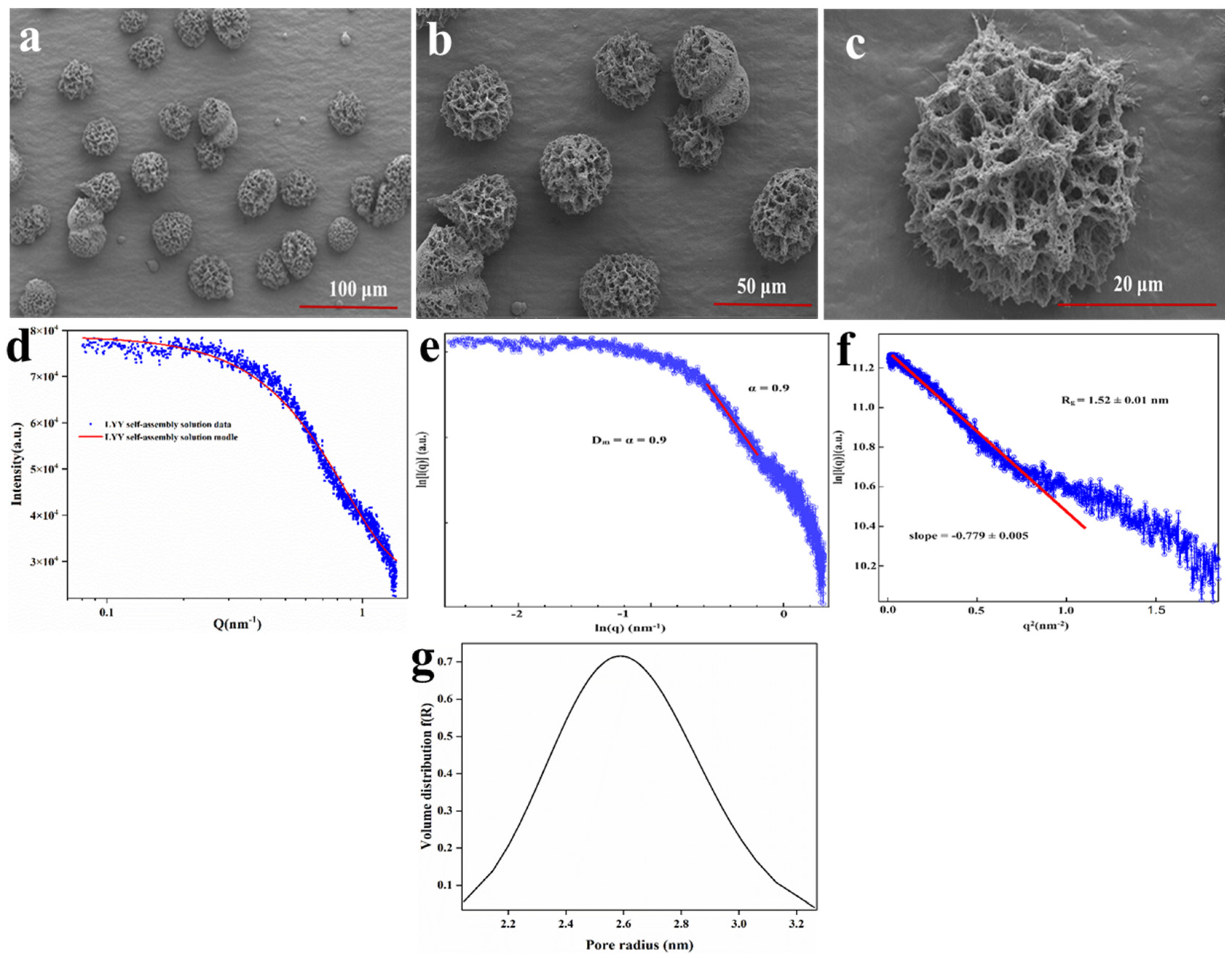
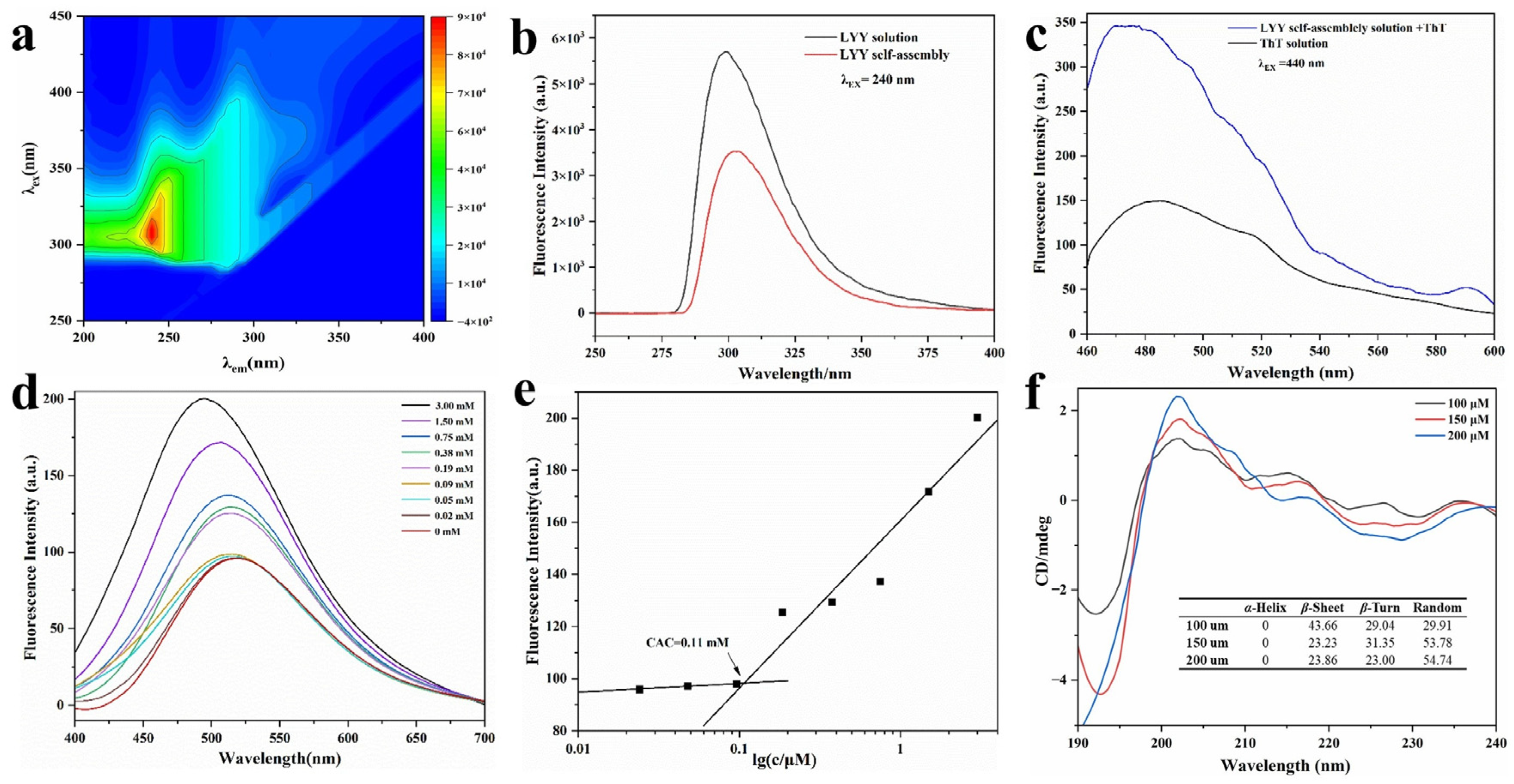

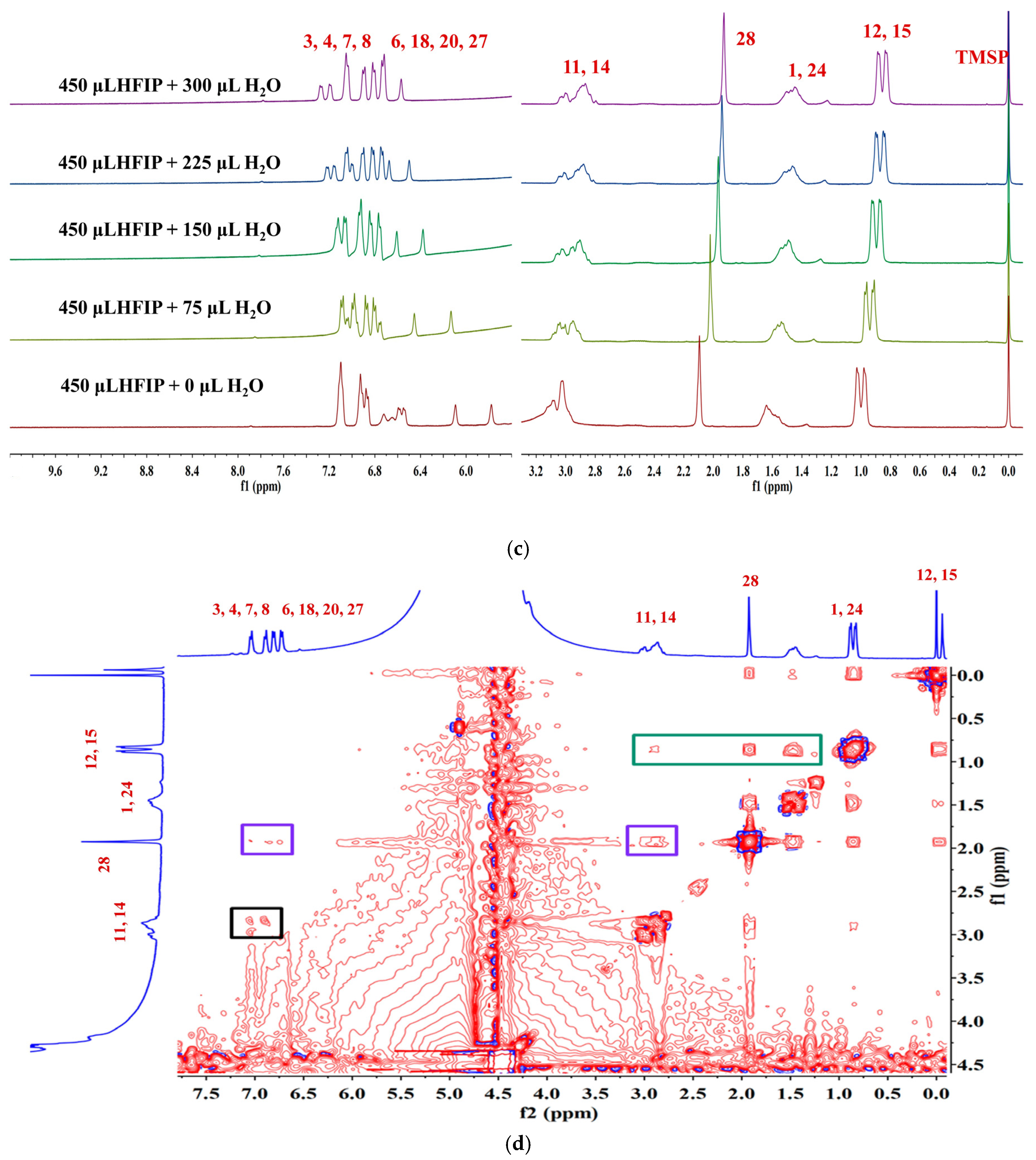

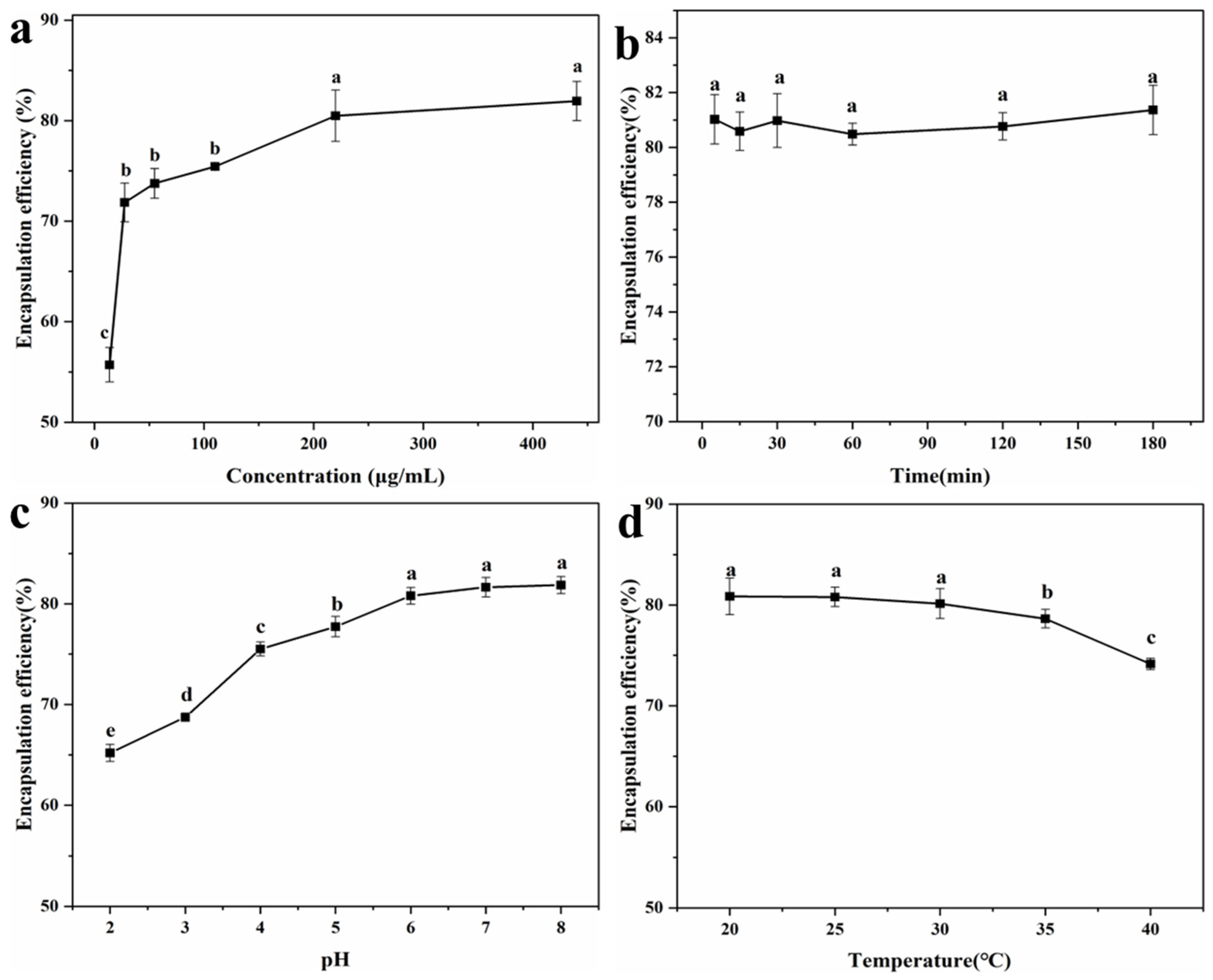


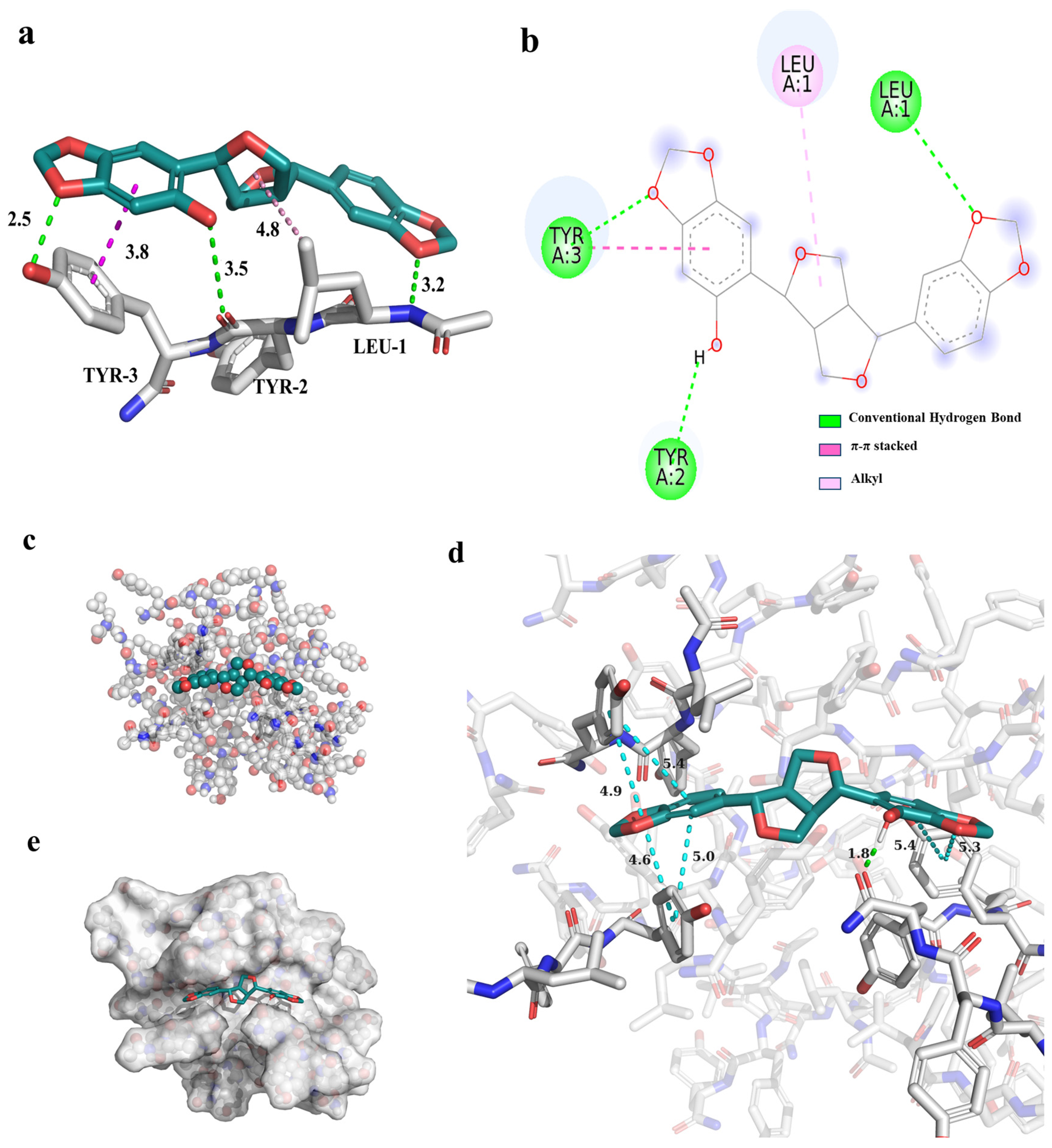
| Entry | Sequence | Water Solubility (mg·mL−1) | Melting Point (°C) | Thermal Stability (°C) | IC50 of DPPH+ Scavenging Ability (μg/mL) | Cell Viability) (at 2.5 mmol of Peptide) % |
|---|---|---|---|---|---|---|
| 1 | LYY | 0.65 ± 0.13 | 243.01 | 308.35 | 846.80 | 90.9 ± 2.1 |
| 2 | RYY | 44.70 ± 1.52 | 263.71 | 303.63 | 4970 | 85.3 ± 1.6 |
| 3 | KYY | 86.70 ± 2.17 | 292.43 | 338.96 | 74,000 | 91.8 ± 4.5 |
| 4 | VYY | 0.30 ± 0.08 | 280.67 | 304.26 | 84,000 | 87.6 ± 2.0 |
| 5 | YLY | 0.56 ± 0.09 | 260.00 | 313.30 | 6.186 × 106 | 91.2 ± 3.6 |
| 6 | YYL | 0.84 ± 0.05 | 292.43 | 301.73 | 37.03 | 89.3 ± 3.8 |
| 7 | IYY | 0.44 ± 0.05 | 301.68 | 305.22 | 5600 | 91.8 ± 2.3 |
| 8 | GYY | 10.2 ± 0.95 | 289.82 | 303.35 | 5.695 × 106 | 88.4 ± 2.9 |
| 9 | AYY | 2.60 ± 0.36 | 292.66 | 297.21 | 8116 | 86.45 ± 3.2 |
| 10 | YY | 16.92 ± 0.83 | 254.25 | 302.18 | 4279 | 91.2 ± 4.2 |
Disclaimer/Publisher’s Note: The statements, opinions and data contained in all publications are solely those of the individual author(s) and contributor(s) and not of MDPI and/or the editor(s). MDPI and/or the editor(s) disclaim responsibility for any injury to people or property resulting from any ideas, methods, instructions or products referred to in the content. |
© 2025 by the authors. Licensee MDPI, Basel, Switzerland. This article is an open access article distributed under the terms and conditions of the Creative Commons Attribution (CC BY) license (https://creativecommons.org/licenses/by/4.0/).
Share and Cite
Gao, J.; Du, H.; Zhang, Z.; Duan, Q.; Yuan, L.; Duan, B.; Yang, H.; Lu, K. Design and Characterization of Peptide-Based Self-Assembling Microgel for Encapsulation of Sesaminol. Foods 2025, 14, 971. https://doi.org/10.3390/foods14060971
Gao J, Du H, Zhang Z, Duan Q, Yuan L, Duan B, Yang H, Lu K. Design and Characterization of Peptide-Based Self-Assembling Microgel for Encapsulation of Sesaminol. Foods. 2025; 14(6):971. https://doi.org/10.3390/foods14060971
Chicago/Turabian StyleGao, Jinhong, Heng Du, Zhenhong Zhang, Qunpeng Duan, Libo Yuan, Bingchao Duan, Hongyan Yang, and Kui Lu. 2025. "Design and Characterization of Peptide-Based Self-Assembling Microgel for Encapsulation of Sesaminol" Foods 14, no. 6: 971. https://doi.org/10.3390/foods14060971
APA StyleGao, J., Du, H., Zhang, Z., Duan, Q., Yuan, L., Duan, B., Yang, H., & Lu, K. (2025). Design and Characterization of Peptide-Based Self-Assembling Microgel for Encapsulation of Sesaminol. Foods, 14(6), 971. https://doi.org/10.3390/foods14060971





